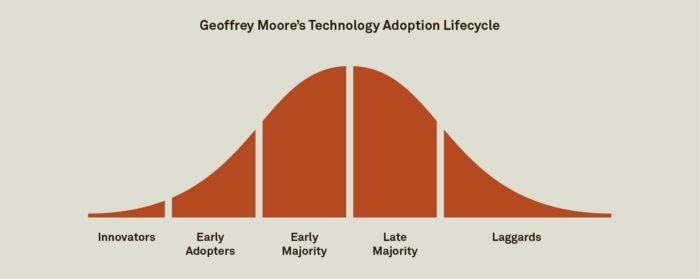Using case studies to tell your story for you
- Fahad H

- Nov 3, 2017
- 4 min read
It’s easy to forget how much those of us in B2B SaaS companies ask of our potential customers.
We’re not just asking them to whip out their credit card and download our product, we’re asking them to change their existing operation and potentially their teammates’ too. This is a big ask.
Case studies make this ask easier. They play a vital role in de-risking this effort, particularly for the vast majority of your potential market who are not technology enthusiasts and are more averse to change. Crossing the Chasm author Geoffrey Moore would categorize these people as the Early Majority, Late Majority, and Laggards:

According to Moore, these are people in the market for step improvements to their existing ways of working, rather than revolutionary changes. They look for tried and true solutions. They want to know that others slightly better than them have successfully used your product.
A good case study fulfills part of this job. As someone who’s produced far too many case studies in my life, early on at Intercom and Atlassian, and on the side for Google, I’ve noticed that the components of great case studies and process for getting them done don’t vary much.
Elements of a case study
Case studies generally follow a tried and true formula: How Person A achieved XYZ by using Product B. What makes the difference between a dry, inauthentic story to one that truly captivates is how you tell it. A good case study shares the elements of a good story, period:
Protagonist: a relatable customer from an aspirational company
Tension: a portrait of their workflow and challenges before using your product
Resolution: how they solved it by replacing their workflow with your product
Tension is the driving force of your case study. It grabs the reader’s interest, puts them in your customer’s shoes, and without it, your resolution (and “BUY NOW!” call-to-action) will sound completely unconvincing. I’ll share questions that get to these sections further down.
Who should you profile?
As the first person at Intercom who worked on case studies (a job now split by my esteemed product marketing colleagues George and Christine), I was given access to our entire customer database and a daunting task: find the best stories.
Moore is prescriptive with who you should target for these stories: “The only suitable reference for an early majority customer, it turns out, is another member of the early majority.” Behavioral data will narrow your pool of customers to those of the right profile, but I’ve always found that the best stories come from a mix of data and customer conversations.
At Intercom, the owner of most of those conversations is our Support team. They go far beyond simply solving customer issues to routing important parts of conversations to different teams, ie. feature requests to Product, bugs to Engineering, and in our case, positive feedback to Marketing.
If you don’t use Intercom there are loads of other sources of positive conversations: ask your execs, your researchers, attend customer meetups, dive into Twitter, Quora, etc.
What should you ask?
Now for the fun part: the customer interview. Treat these more like informal conversations, in the sense that it’s good to have a few questions to structure your conversation, but let the customer talk freely. You want to hear their passion and put that on a page.
Use the interview to dig into the three elements of a story I mentioned above, spending most of your time teasing out Tension and Resolution. By now you should’ve done plenty of research to paint a favorable portrait of your Protagonist. Here are some questions to get a conversation going:
Protagonist
I’ve read your marketing site, but in your own words what does your company do?
What is your role and how does it relate to your business goals?
Tension
Can you tell me how you started using Intercom?
What tools or workflow were you using before Intercom? If the customer started with Intercom, what would you have done if Intercom didn’t exist?
What jobs does Intercom solve for you?
Resolution
What does your workflow look like now?
What makes Intercom the right fit for your company?
What are some of the benefits you’ve seen- both qualitative and quantitative?
As a rule of thumb if you can keep your subject talking about their use case for half an hour, you’ll have enough information to write a case study. For really specific questions that may require some due diligence on the part of your customer, such as data points, it’s often better to send questions in a follow-up email.
A final tip: I always record these conversations – with their permission, of course – so I can hyper focus on what the customer is saying.
Where does a customer story live?
The cheeky answer is: everywhere. Customer stories can be spliced in infinite ways and surfaced throughout your customer’s journey to add that extra little dash of credibility. They can range from super lightweight to big budget productions. They can be turned into a paid ad or an anecdote your spokesperson tells a journalist. Early on, your two biggest internal stakeholders will probably be Sales and Product Marketing, but later that can extend to Demand Generation, Events, Comms, Content, etc.
Crossing the chasm
Often when you ask a content marketer to work on a customer story, you’ll see their eyes glaze over. Customer stories are sometimes dismissed as low-level, formulaic work. In reality, the process exposes you to your most passionate customers and will instil a profound sense of empathy and appreciation for them, which which will carry you throughout your career. They’re also one of these few things no one can blatantly rip off. And the output, when done well, plays a pivotal role in helping tip the vast majority of potential users over the fence.









Comments